When ‘THE BRAVEST OF THE BRAVE’ 123 Indian Soldiers gave a run of life to 5000 Chinese soldiers!
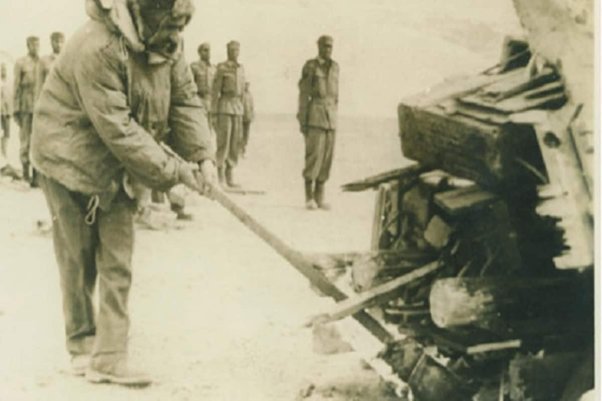

“थी खून से लथ-पथ काया !
फिर भी बन्दूक उठाके !
दस-दस को एक ने मारा !
फिर गिर गये होश गँवा के !
जब अन्त-समय आया तो !
कह गये के अब मरते हैं !
खुश रहना देश के प्यारों !
अब हम तो सफ़र करते हैं !
क्या लोग थे वो दीवाने !
क्या लोग थे वो अभिमानी !!!”
Since my childhood days till this time, I have heard the above lines numerous times that has given me goosebumps everytime I heard them. But I was unable to relate these lines which was written for any specific battle. Then I came to know and read in detail about this war “Battle of Rezang La” which was fought by ‘THE BRAVEST OF THE BRAVE‘ 123 INDIAN Soldiers on a frosty night of 18th Nov, 1962.
How our men fought to ‘the last men, last round’ at Rezang La (Chushul) on November 18, 1962, and caused heavy damage to the Chinese army. The tale of courage and bravery of Major Shaitan Singh who not only motivated his men but also sacrificed his life fighting and saving the post. This battle is listed in the 8 stories of collective bravery published by UNESCO.
The Chinese did not just stop with some border skirmishes, they actually built roads right up to Spanggur Gap in the West, and Walong in the East. India on the other hand was caught napping literally, to face it’s worst defeat ever. But then even in moments of darkness, there have been moments that shone through, and during the ’62 war, it was the to the last man standing resistance at Rezang La, against all odds, that to date, has been one such moment.
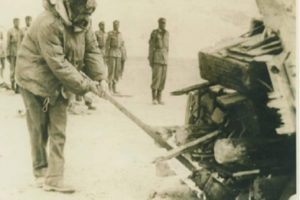
All this happened at a height of 16,000 feet in the freezing cold against the heavy attack from the enemy. But the Charlie Company of the 13th Kumaon battalion didn’t give up. For every man lost by us, the enemy lost four to five. It is no hidden fact that India’s defeat in the 1962 war was tragic but the sacrifice of Major Shaitan Singh and his men will always be remembered for their supreme courage and devotion towards their duty.
In the annals of Indian Military history,Rezang La, would be mentioned in the same breath as other “to the last man standing” battles like Masada, Alamo, Charge of the Light Brigade and Thermopylae. Or if we take a more recent example, Battle of Kasserine Pass in North Africa, during World War II, where the Allied forces went down, fighting to the Axis forces.
LOCATION –
To understand it take a look at the above figure (Source: Bharat Rakshak), Chushul valley where Rezang La is located, was pretty much a barren, sandy strip. Around 40 Km long, and just 5.6 km at it’s widest, Chushul is located at an altitude of 14,230 ft surrounded by towering mountains. On the northern side is the spectacular Pangong Tso lake, while the eastern and western parts are filled with high mountain peaks. In the South there was an all weather airfield, and the east had the Spanggur Gap. Chushul was considered strategically important, and much before the war, itself, China, had built roads that could carry tanks all the way up to Spanggur. Chushul was the main nodal point for all Indian military outposts in this sector, and it’s defense was seen as vital.
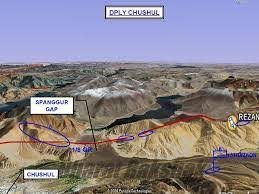
About the ‘Ahirs’ Company( 13th Kumaon Battalion)
The 13 Kumaon was raised on August 5,1948 by Lt.Col. H.C.Taylor, with around 50% of Kumaonis and Ahirs from Haryana. In 1956, this was made a 100% Ahir battalion, on the suggestion of the then Regiment Colonel, K.S.Thimayya, and the process was complete by March 1960. The Ahirs claim to be Somvanshi Kshatriyas, one of the major Yadav clans, it is for this reason, that Ahir and Yadav are used interchangeably. One of the influential communities in Haryana, they reside mostly in the Rewari-Narnaul area . One of the most important Ahir heroes was Rao Tula Ram, a key leader of the 1857 Rebellion, who played a key role in checking the British advance into South west Haryana, and also assisted the rebels in Delhi.
Prior to 1962, the 13 Kumaon had experience, fighting the Naga counter insurgency in the Naga Hills led by the self styled leader, Kito Sema. The battalion had shown it’s prowess, by capturing weapons, many self styled generals and commanders of the underground Naga Army, and also destroying their HQ. It was the tough counter insurgency operations in Naga Hills( now Nagaland), that made 13 Kumaon a battle hardened unit, ready for actual combat.
13 Kumaon had already moved to Baramulla for training, at high altitude, in anticipation of the war ahead. By Oct 2,1962 they had moved to Leh along with 114 Infantry Brigade, and was scheduled to go to Chusul by March 1963. With intelligence reports of an impending Chinese attack on Chusul, the 3rd Infantry Division was raised hurriedly. By Oct 13, the B and C companies of 13 Kumaon were sent to Chushul, and took charge of Mugger Hill and Rezang La Pass. The D company of 13 Kumaon, occupied the vital Spanngur Gap, while the Battalion HQ was located in the High Ground.
Under Major Shaitan Singh, 3 Platoons were deployed at Rezang La, one on the Northern side under Jemadar Surja, another in the pass under Jemadar Hari Ram, and south under Jemadar Ram Chandar. The Company C HQ was under the charge of Naik Ram Kumar Yadav along with 3 Inch Mortar.
The Chinese had 3 ways to reach Chushul, one was the pretty much circuitous route from Khurnak Fort through Leh, and only a battalion with support of animal transport could move. The other route was from Rudok to Chushul, which had a class 9 road and the 3rd approach was from Rudok to Chushul via Rezang La. The 114 Infantry was given the task of defending Chushul for as long as it could from the enemy forces, quite ambitious, considering it’s lack of troops and fire power.
Rezang La was the pass that lay on the South Eastern approach to Chusul, it was being manned by C Company of 13 Kumaon under the leadership of Major Shaitan Singh. Located at an altitude of 16,000 feet above sea level, it was roughly around 3 km long and 2 km wide. The fact is that the troops were ill prepared for the defense, with no mechanized digging equipment, they had to manually dig defenses in the rocky terrain. The hard job, couple with the lack of oxygen, the biting cold, made the task of the men, even tougher, many of whom were not yet acclimatized to the conditions. Add to it, the local ponies and yaks carrying the woolen clothing, rations, sleeping bags had not yet arrived.
There was another serious issue, the pass was surrounded by high mountain peaks, which were an impediment to artillery shells, and this denied them a proper artillery backup. No artillery support, using .303 rifles which were of WWII vintage, no proper woolen clothing and ancient radio sets, which could not communicate due to frozen batteries,that was the state of the Indian side. In sharp contrast, the Chinese had 7.62 SLR’s( Self Loading Rifles) and the troops were acclimatized to the conditions. Also the Chinese troops consisted of locals from Singkiang, who were familiar with the region and climate, while the Indian side was made of Ahirs, who coming from North Indian plains, and deployed in high altitude for the first time, were totally unfamiliar with the environment. The unit also did not have sufficient time to stock and place out mines, and there was also no mutual support for the sub units, due to the wide spaces. Also the lack of artillery support due to the topography, and not enough mines to slow down enemy advances.
On Oct 24, Order was issued to fight to the last man standing, there was nothing else to do, considering the inadequate preparations. After a heavy snowstorm, on Nov 17, at 2 AM on Nov 18, movements of Chinese soldiers were observed by Lance Naik Brij Lal, who rushed back to inform to Platoon 8 HQ. Soon the entire C company was alerted.
Now coming to the indomitable spirit story which is still unparalleled in any of the military history worldwide. The courage is so overwhelming that it is almost impossible for the human soul to even grasp that such braves walked the face of this very earth.
On 18th Nov 1962, Maj. Shaitan Singh Bhati and the men of Charlie company comprising 120 jawans were assigned a task to protect Chushul airfield (currently comes under Leh Dist. in Ladakh). In their initial assault on Indian positions in Oct, the chinese had invaded border posts from Daulat Beg Oldie to Damchok along the Karakoram range. The defence of Chushul was the responsibilty of 114 Brigade, which had a batallion less. An Infantry Brigade had just 3 battalions. 114 brigade had just 1/8 Gurkha Rifles and 5 Jat Regiment. When the danger to Chushul was realised, 13 Kumaon was rushed from Baramulla to augment 114 Brigade. Other companies of 13 Kumaon occupied heights like Gun Hill, Gurung Hill and Mugger Hill. Charlie company was given Rezang La (a mountain pass on LAC), 19 km away on the southeastern approach to Chushul. Rezang La was all rock, bitterly cold with bone chilling winds. The company was deployed at a height of 16,405 feet above sea level and the main company position was defended by the 7th, 8th and 9th platoons.
It was a group of 5000 Chinese soldiers holding positions against the isolated post of 120 Indian soldiers. With no reinforcements in sight and without any artillery back up, the Indian troops led by Major Shaitan Singh decided to hold on. He told that he had instructions from the Brigade head quarters to fall back because they felt that they can’t be supported by artillery and they also felt that this was a lost battle for them. But the Major choose to stay there because that is what the ‘Honor of Soldier’ demands. If any of the soldiers had wished to go back they’re welcome, and he had not hold it against them. They were 123 in number, which comprised of 1 officer, 122 others of JCOs and another ranks. The contingent told to Major Sahab, they would stick with him and they were not going back. Then this officer Major Bhati told them one thing, “Dosto, yahan pe jeet nhi hogi 24 ghante ke andar hum sab Shaheed hone wale hai” ( I know we can’t win this battle, this battle can’t be won, we are going to Die within 24 hrs), We are just 123 and they are 5000, We are surrounded and we have one small way to get out from here, again I ask you ‘Do you wish to leave?’ or ‘Shall we become martyers tonight?’ and all of them to a man agreed that “ Tonight all of them will die.”
Major Shaitan Singh, confirmed that all the unit soldiers were at their positions. The Chinese plan was to launch a massive surprise attack, but it was coming to nought, with the C company on full alert. At 5 AM, the Chinese soldiers were spotted by all the Ahirs manning the defenses, and the first round of firing through LMG’s, MMGs and mortars began. The Chinese launched 4 attacks trying to overwhelm through a wave formation.
But the spirited resistance, meant many of them lay dead in the gullies. The casualties were mounting on the Indian side too, with many Ahirs falling to Chinese bullets. Naik Chandgi Ram, launched a counter attack on the invading Chinese, using his bayonet, killing around 6-7. The first wave of Chinese attacks were beaten back by 5:45 AM. Rezang La was not turning out to be the walk in the park, that they had expected it to be. Understanding that a full frontal attack was not effective, the Chinese began to use their artillery fire power.
The superior Chinese artillery, overwhelmed most of the Indian positions, the Command Center was shelled. Major Shaitan Singh had the unenviable task of regrouping his remaining officers, to take on the Chinese invaders, who by now were beating down furiously. Shaitan Singh, moved from one gun position to another, exhorting his depleting defenses to keep fighting till the last man. He was hit by LMG fire on the arm, but that did not deter him as he kept firing at the enemy, with whatever limited resources he had.
The Battle
This has been a very unique and breathtaking saga of ultimate bravery, which is still remembered as the greatest last stand ever taken in any Military Warfare.
In the very early hours of 18th Nov, the Chinese army attacked the 7th and 8th platoon. Then the Charlie company attacked, opened up with rifles, machine guns and Mortars. The retaliation was so ferocious that hundreds of Chinese soldiers laid dead.
The Chinese attacked again and again and again. The Indians repulsed, surrounded & heavily outnumbered, the men fought with rare determination repulsing the waves of Chinese army one after the other and there was a time when the Charlie company ran out of ammunitions. As the ammunitions finished, the bravehearts fought the enemies bare handed and in closed combat killed nearly 1300 Chinese soldiers.
Major Shaitan Singh Bhati was constantly fighting, moving from platoon to platoon, encourgaing his men and leading from the front. During this course of battle, he was critically injured by MMG Fire. While being evacuated, the Chinese started firing at him and the two soldiers who were accompanying him. Not wanting his soldiers to be killed in such a manner, he ordered them to leave him with his weapon and rejoin the fighting.
Another burst of enemy fire, hit Shaitan Singh in the stomach, and he was pulled to safety by Phool Singh and Jai Narain Singh. He ordered his men to leave him, and rush to the defense of the Battalion, and he slowly froze to death with a grenade in his hand.
On the other side, 1/8 GR fought valiantly in Spanggur Gap, with artillery back up and tanks destroying the enemy advances. Lt. Goswami gave ample to the defense of Gurung Hill under Capt P.L.Kher, losing his own legs due to frost bite, would be decorated with a Mahavir Chakra. Havildar Major Harpool Singh, led 3 other survivors to stop the enemy onslaught before falling, while Naik Ram Kumar, held back the invading Chinese soldiers with his own .303 rifle, before he was badly injured in a grenade attack.
As the last round was fired, and the last soldier fell, a shroud of silence enveloped Rezang La, no reinforcements could be provided to the C Company nor any was asked for either. Ceasefire was declared 3 days later on Nov 21, 1962. The sacrifice and raw heroism shown by C Company against all odds would never be forgotten. The body of Major Shaitan Singh was discovered in February 1963, still clutching his hand grenade, and so were bodies of around 96 soldiers,still clinging to their weapons.
The Brave-Major Shaitan Singh(PVC) –
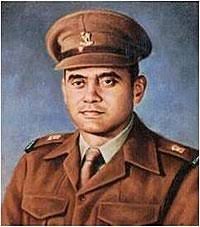
Charlie Company, 13 Kumaon, repulsed totally seven attacks in order to save the posts by the chinese before the entire company was martyred in combat.
On 21st Nov, 1962, a unilateral ceasefire was declared between India and China.
Out of the 123 soldiers of the Charlie Company 114 were martyred and 6 were captured by the Chinese army and kept as POWs. They later miraculously escapsed.
For his conspicuous valour, leadership, courage & determination beyond the call of duty, Major Shaitan Singh was posthumously awarded a grateful nation’s highest gallantery award Param Vir Chakra. The company was also awarded 8 Veer Chakras and 4 Sena Medals for exceptional bravery. Charlie company was later re-designated as “ReZang La Company”.
Post Battle
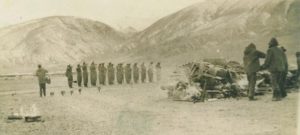
It was heroism against all odds, an outnumbered, batallion, with outdated equipment, holding back a much larger and better equipped invading force. These 114 men who laid down their lives, ensured that the Chinese side would lose a whole lot of theirs too.
The 1962 India China war, an event that most of us would like to forget, one of the most ignominious chapters in the history of India, post Independence. China was seeking to assume leadership of the Afro Asian nations, and it saw India as a serious rival, which was doing the same through NAM. More than that, India granting asylum to the Dalai Lama, it’s tacit support to the revolt in Tibet, was seen in a not too positive light by China. Also China never really accepted the McMahon line that served as the boundary between the two nations. 1962 was not the first time, China had attacked India, there had been border skirmishes earlier too in 1959, seizing a border post at Longju in the North East, and another being an attack at Konga, around 80 Km straight into Indian territory.
Last but not the least few lines for those Veer Saput of Bharat mata.
“Tha Chushul ghati rezang la ka, Darra thartharaya tha, terah Kumaon ke veer putro ne, Ladakh ko tab bachaya tha!!”
“Thi Samne Diwar si Choti, Gole Barud the khatam hue, Chaku-chhude aur Patharo se the jawan tab lad pde!!”
“Nange Hatho tab Yudhh Kiya, Shaitan Singh n Chhubdh hua, Ram Singh ke mallla-Yudhha se, Dushman tha vilupt hua!!”
“Hue Shaheed 114, maar giraye the 1300, ek ek ne 10 ko maara tha, Veer-Sena-Paramveer Chakra paya tha!!”
Jai Hind!! Vande Matram!!
DISCLAIMER: The author is solely responsible for the views expressed in this article. The author carries the responsibility for citing and/or licensing of images utilized within the text.
